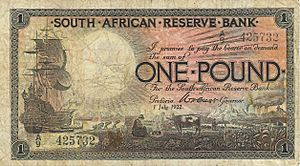South African pound facts for kids
Quick facts for kids South African pound |
|
|---|---|
| User(s) | Goshen |
| Subunit | |
| 1⁄20 | shilling (sjieling) |
| 1⁄240 | penny (pennie) |
| Symbol | £ |
| shilling (sjieling) | s or /– |
| penny (pennie) | d |
| Plural | pond (Afrikaans) |
| penny (pennie) | pence (English) |
| Coins | |
| Freq. used | 1⁄4d, 1⁄2d, 1d, 3d, 6d, 1/–, 2/–, 2/6 |
| Rarely used | 5/– |
| Banknotes | 10/–, £1, £5, £10, and £100 |
The South African pound (called pond in Afrikaans, symbol £) was the money used in the Union of South Africa. It became the official currency when South Africa was formed as a British Dominion in 1910. The South African pound was replaced by the rand in 1961. This happened when South Africa changed its money system to use decimals (like our modern money).
Before 1910, the British pound was the main currency in the Cape Colony and other British areas in Southern Africa. This started in 1825 when a special rule made British coins legal money in all British colonies. Back then, one pound was divided into 20 shillings, and each shilling had 12 pence.
Contents
History of the South African Pound
The British pound became the official money in the Cape of Good Hope colony in 1825. This was part of a plan to use British coins in all British colonies. British money then took the place of the Dutch currency that was used before.
Money Before the Union of South Africa
Before South Africa became one country, different areas had their own money. These currencies were usually worth the same as the British pound.
The Transvaal Republic, a Boer state, printed its own money from 1867 to 1902. They also made coins from 1892 to 1902. The gold coins from Transvaal were called "pond" instead of "pound" in Afrikaans.
The South African Reserve Bank
In 1920, the government issued special gold paper money. The next year, in 1921, the South African Reserve Bank was created. This bank became the only place allowed to print banknotes. Coins for the South African pound started being made in 1923.
The South African pound was usually worth the same as the British pound. However, there was a short time after 1931 when this changed. In 1931, the United Kingdom stopped using the gold standard. This meant their money was no longer directly linked to a certain amount of gold.
South Africa, however, decided to stick to the gold standard for a while. This made the South African pound much stronger than the British pound. But this also made it very hard for South Africa to sell its gold to London, which was a big part of their economy. By 1933, South Africa also stopped using the gold standard. The South African pound then went back to being worth the same as the British pound, and the economy improved quickly.
When the Pound Changed to Rand
The South African pound was replaced by the rand on February 14, 1961. This was part of a change to a decimal system. One South African pound became equal to two rand (R2 = £SA1). The rand kept this value against the British pound until 1967.
Coins of the South African Pound
Coins from the Transvaal Republic
In 1892, the Transvaal Republic started making coins. These included small coins like 1d (penny), 3d, 6d, and shillings (1/–, 2/–). They also made larger coins like 2/6, 5/–, and gold coins worth £1⁄2 (10/–) and £1. The last of these coins were made in 1900.
Coins from the Union of South Africa
The Union of South Africa began issuing its own coins in 1923. These coins came in values like 1⁄4d, 1⁄2d, 1d, 3d, 6d, 1/–, 2/– (also called a florin), 2/6, and gold coins worth £1⁄2 and £1. The gold coins were known as the half sovereign and sovereign.
The South African coins weighed the same as British coins. However, the silver coins (from 3d to 2/6) were made with a bit less silver. Gold coins were made until 1932.
In 1947, 5/– coins were introduced. Some of these were special coins made to celebrate events. In 1951, the silver coins started to be made with even less silver. From 1952, gold coins worth £1⁄2 and £1 were made again, similar to the half sovereign and sovereign.
All the coins had the picture of the monarch (the king or queen) on one side. The other side showed the coin's value and "South Africa" written in both English and Afrikaans.
Banknotes of the South African Pound
Before the South African Reserve Bank, different groups issued banknotes. For example, the government of the Cape Colony issued a £1 note in 1835.
Between 1869 and 1872, the ZAR (Transvaal Republic) printed notes for small amounts like 6d, 1/–, and 2/6, up to larger amounts like £1, £5, and £10. During the Second Boer War, the government also issued notes for £1, £5, £10, £20, £50, and £100.
In 1920, special gold certificate notes were issued. These came in very large values, from £1 up to £10,000. They had text in both Afrikaans and English.
From 1921, the South African Reserve Bank became the main issuer of paper money. They introduced notes for 10/–, £1, £5, £20, and £100. The £20 notes were last printed in 1933, and £10 notes were added in 1943.
All banknotes were printed in both English and Afrikaans. After 1948, two versions of each note were made. One had English written first, and the other had Afrikaans written first.
See also


